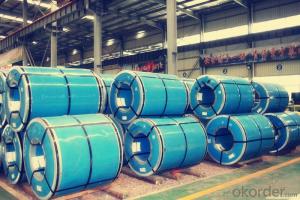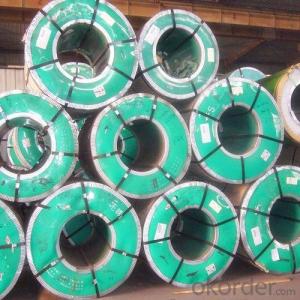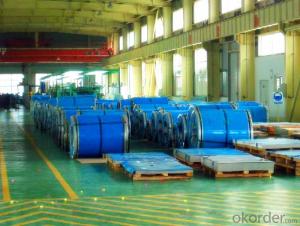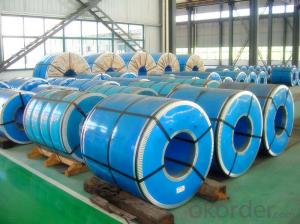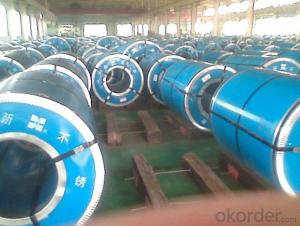Stainless Steel Coil/Sheet 304 Cold Rolled BA/NO.1
- Loading Port:
- Ningbo
- Payment Terms:
- TT OR LC
- Min Order Qty:
- 100 m.t.
- Supply Capability:
- 20000 m.t./month
OKorder Service Pledge
OKorder Financial Service
You Might Also Like
Chemical composition: | |||||||
C | Si | Mn | Cr | Ni | S | P | |
≤0.07 | ≤1.0 | ≤2.0 | 18.0~20.0 | 8.0~11.0 | ≤0.03 | ≤0.035 | |
mechanical properties: | |||||||
Tensile strength σb (MPa) | Conditions yield strength 0.2 sigma (MPa) | Elongation δ5 (%) | Section shrinkage (%) | Hardness | |||
520 | 205 | 40 | 60 | ≤1 | |||
Standard: | AISI,ASTM,BS,DIN,GB,JIS | Grade: | 304 | Thickness: | 0.3-3.0mm |
Place of Origin: | China Mainland | Brand Name: | CNBM | Model Number: | 304 |
Type: | Steel Coil | Technique: | Cold Rolled | Surface Treatment: | 2B, BA |
Application: | Medical instruments, building, chemical food industry agriculture | Width: | 500-2000mm | Length: | Coil |
finish: | 2B, BA | item: | 304 cold rolled stainless steel coil | density: | 7.93 |
Hot Rolled Stainless Steel Coil 304 Annealing and Pickling No.1 Finish
Stainless steel is a production which not easy rust,acid resistance and corrosion resistance,so it is widely
used in light industry,heavy industry,daily necessities and the decoration industry.
Hot Rolled Stainless Steel Coil 304 Specifications
1.surface:NO.1
2.standard:JIS, AISI, GB
3.width: 0.55m, 0.65m, 1.0m, 1.22m, 1.5m, 2m or requirement
Hot Rolled Stainless Steel Coil 304 Chemical Composition:
(%):C=0.07, Mn=2.00, P=0.045, S=0.030, Si=0.075, Cr=17.5-19.5, Ni=8.0-10.5, N=0.10
Hot Rolled Stainless Steel Coil 304 Physical Properties
Tensile strength σb (MPa) ≥ 520
the conditions yield strength σ0.2 (MPa) ≥ 205,
elongation δ5 (%) ≥ 40
Reduction of ψ (%) ≥ 50,
hardness: ≤ 187
HB; ≤ 90
HRB; ≤ 200H
- Q:Is there any magnetism in stainless steel?
- Iron and steel are different in terms of carbon content. An iron carbon alloy with a carbon content of less than 2% is a steel, and a carbon content of more than 2% is called iron. Steel is widely used because of its toughness, elasticity and rigidity. Life is exposed to steel, but people call different. For stainless steel, whether or not the magnet is sucked on or not, as long as the quality standards are met, it is stainless steel. Therefore, from the perspective of metallurgy said, no rust said. The main element of stainless steel corrosion resistance is chromium. If the content of chromium is above 10.5%, the steel will not rust. When smelting, the alloy elements added are different, so there is a difference between the magnet and the suction. Stainless steel is usually divided according to the structure of the organization, can be divided into austenite, ferrite, martensite and other major categories.
- Q:What are the common uses of stainless steel strips in the construction industry?
- Stainless steel strips are commonly used in the construction industry for various applications such as cladding, roofing, structural supports, and decorative elements. They provide durability, corrosion resistance, and aesthetic appeal, making them an ideal choice for exterior and interior design purposes. Additionally, stainless steel strips can be easily fabricated, bent, and welded, enabling their use in a wide range of construction projects.
- Q:Are stainless steel strips suitable for solar panel mounting?
- Indeed, solar panel mounting can be effectively achieved using stainless steel strips. Renowned for its enduring nature, resistance against corrosion, and remarkable strength, stainless steel emerges as an optimal selection for outdoor purposes such as solar panel placement. These strips are capable of withstanding severe weather conditions encompassing strong winds, heavy rain, and snow, without succumbing to corrosion or degradation over time. Moreover, stainless steel furnishes a steadfast and secure foundation for solar panels, guaranteeing their firm positioning and efficient utilization of sunlight for energy production. In summary, stainless steel strips present themselves as a dependable and enduring alternative for the mounting of solar panels.
- Q:Stainless steel pan with magnetic or good without magnetic stainless steel pot?
- Without magnetic material if it is of course good 316304 of the material, if it is 201202 or easy to rust, the magnetic material is 443 than 304, this is due to their corrosion resistance, high heat conduction rate of 443, in the province of gas when cooking, can also be used with magnetic pot do the electromagnetic oven, 443 material pot is cheaper than 304, considering the magnetic well
- Q:What is the weight of stainless steel strips?
- The weight of stainless steel strips can vary depending on their dimensions and thickness.
- Q:What are the standard coil sizes for stainless steel strips?
- The standard coil sizes for stainless steel strips typically range from 0.25 inches to 12 inches in width and 0.020 inches to 0.125 inches in thickness. However, these sizes can vary depending on the specific manufacturer and customer requirements.
- Q:Are stainless steel strips suitable for pressure piping?
- Yes, stainless steel strips are suitable for pressure piping. They have high strength, excellent corrosion resistance, and can withstand high pressure environments, making them a reliable choice for various applications in pressure piping systems.
- Q:Does the 301 stainless steel band contain magnetism?
- No magnetism. Related to stainless steel information, you can pay attention to "I want stainless steel" website, I usually look at it above, registered members can also see relevant member information. You can pay attention to it!
- Q:How are stainless steel strips packaged for shipping?
- Stainless steel strips are typically packaged for shipping in a way that ensures their protection and prevents any damage during transportation. The packaging process involves several steps to ensure safe delivery to the destination. Firstly, the stainless steel strips are carefully wrapped in a protective material such as plastic or foam. This helps to prevent scratches, dents, or other surface damages during transit. The protective material also acts as a barrier against moisture and other external elements that could potentially cause corrosion. Next, the wrapped stainless steel strips are placed in sturdy cardboard boxes or wooden crates. These containers are selected based on the size and weight of the strips to provide adequate support and protection. The boxes or crates are reinforced with additional cushioning materials, such as foam inserts or bubble wrap, to absorb any shocks or impacts that may occur during handling or transit. To further secure the stainless steel strips, packaging materials like strapping bands or stretch wrap are used to hold the bundles together. This prevents any movement or shifting of the strips inside the packaging, reducing the risk of damage. Additionally, proper labeling is essential for accurate identification and handling during shipping. Each package is labeled with relevant information including the product description, dimensions, weight, destination address, and any other necessary instructions. Lastly, the packaged stainless steel strips undergo a quality control check to ensure that all packaging requirements are met. This includes verifying the integrity of the packaging materials, confirming the accuracy of labeling, and conducting a final inspection to ensure the strips are properly protected. In summary, stainless steel strips are packaged for shipping by wrapping them in protective materials, placing them in sturdy containers with cushioning, securing the bundles, labeling them accurately, and conducting quality control checks. These packaging measures are crucial to ensure the safe transportation of stainless steel strips and to prevent any damage or corrosion during shipping.
- Q:What is the thickness range for stainless steel strips?
- Depending on the specific grade and application, the thickness of stainless steel strips may vary. In general, these strips can be obtained in thicknesses ranging from 0.0015 inches (0.0381 mm) to 0.125 inches (3.175 mm). This extensive range provides versatility for their widespread utilization in industries like automotive, aerospace, construction, and manufacturing.
1. Manufacturer Overview |
|
|---|---|
| Location | |
| Year Established | |
| Annual Output Value | |
| Main Markets | |
| Company Certifications | |
2. Manufacturer Certificates |
|
|---|---|
| a) Certification Name | |
| Range | |
| Reference | |
| Validity Period | |
3. Manufacturer Capability |
|
|---|---|
| a)Trade Capacity | |
| Nearest Port | |
| Export Percentage | |
| No.of Employees in Trade Department | |
| Language Spoken: | |
| b)Factory Information | |
| Factory Size: | |
| No. of Production Lines | |
| Contract Manufacturing | |
| Product Price Range | |
Send your message to us
Stainless Steel Coil/Sheet 304 Cold Rolled BA/NO.1
- Loading Port:
- Ningbo
- Payment Terms:
- TT OR LC
- Min Order Qty:
- 100 m.t.
- Supply Capability:
- 20000 m.t./month
OKorder Service Pledge
OKorder Financial Service
Similar products
New products
Hot products
Hot Searches
Related keywords
